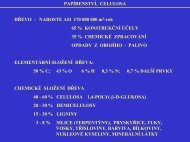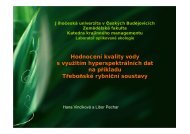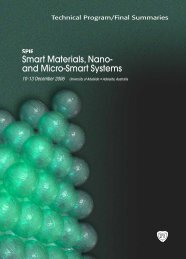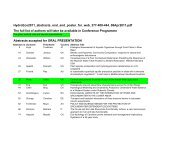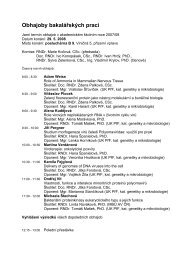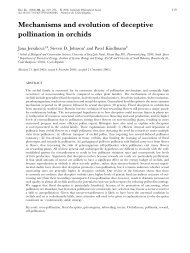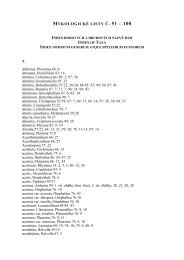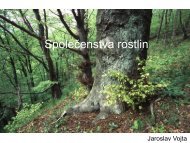The evolutionary history of testicular externalization and the origin of ...
The evolutionary history of testicular externalization and the origin of ...
The evolutionary history of testicular externalization and the origin of ...
Create successful ePaper yourself
Turn your PDF publications into a flip-book with our unique Google optimized e-Paper software.
<strong>The</strong> <strong>evolutionary</strong> <strong>history</strong> <strong>of</strong> <strong>testicular</strong> <strong>externalization</strong> <strong>and</strong> <strong>the</strong> <strong>origin</strong> <strong>of</strong> <strong>the</strong> scrotum 27<br />
<strong>The</strong> <strong>evolutionary</strong> <strong>history</strong> <strong>of</strong> <strong>testicular</strong> <strong>externalization</strong> <strong>and</strong> <strong>the</strong> <strong>origin</strong> <strong>of</strong><br />
<strong>the</strong> scrotum<br />
KAREL KLEISNER *1 , RICHARD IVELL 2 <strong>and</strong> JAROSLAV FLEGR 1<br />
1<br />
Department <strong>of</strong> Philosophy <strong>and</strong> History <strong>of</strong> Science, Charles University, Viničná 7, 128 44 Prague, Czech Republic<br />
2<br />
School <strong>of</strong> Molecular <strong>and</strong> Biomedical Science, University <strong>of</strong> Adelaide, Adelaide, SA5005, Australia<br />
*Corresponding author (Email, kleisner@seznam.cz)<br />
This paper re-examines <strong>the</strong> evolution <strong>of</strong> <strong>the</strong> scrotum <strong>and</strong> <strong>testicular</strong> descent in <strong>the</strong> context <strong>of</strong> <strong>the</strong> recent phylogeny<br />
<strong>of</strong> mammals. <strong>The</strong> adaptive significance <strong>of</strong> <strong>testicular</strong> descent <strong>and</strong> scrotality is briefly discussed. We mapped four<br />
character states reflecting <strong>the</strong> position <strong>of</strong> testes <strong>and</strong> presence <strong>of</strong> scrotum onto recent mammalian phylogeny. Our<br />
results are interpreted as follows: as to <strong>the</strong> presence <strong>of</strong> testicondy in Monotremata <strong>and</strong> most <strong>of</strong> Atlantogenata, which<br />
represent <strong>the</strong> basal group <strong>of</strong> all eu<strong>the</strong>rians, we argue that primary testicondy represents a plesiomorphic condition for<br />
Eu<strong>the</strong>ria as well as for all mammals. This is in opposition to <strong>the</strong> previous hypo<strong>the</strong>sis <strong>of</strong> Werdelin <strong>and</strong> Nilsonne that <strong>the</strong><br />
scrotum may have evolved before <strong>the</strong> <strong>origin</strong> <strong>of</strong> mammals <strong>and</strong> <strong>the</strong>n repeatedly disappeared in many groups including<br />
monotremes. We suggest that <strong>the</strong> scrotum evolved at least twice during <strong>the</strong> <strong>evolutionary</strong> <strong>history</strong> <strong>of</strong> mammals, within<br />
Marsupialia <strong>and</strong> Boreoeu<strong>the</strong>ria, <strong>and</strong> has subsequently been lost by many groups; this trend is especially strong in<br />
Laurasia<strong>the</strong>ria. We suggest that <strong>the</strong> recent diversity in <strong>testicular</strong> position within mammals is <strong>the</strong> result <strong>of</strong> multiple<br />
selection pressures stemming from <strong>the</strong> need to provide conditions suitable for sperm development <strong>and</strong> storage, or to<br />
protect <strong>the</strong> male gonads from excessive physical <strong>and</strong> physiological disturbance.<br />
[Kleisner K, Ivell R <strong>and</strong> Flegr J 2010 <strong>The</strong> <strong>evolutionary</strong> <strong>history</strong> <strong>of</strong> <strong>testicular</strong> <strong>externalization</strong> <strong>and</strong> <strong>the</strong> <strong>origin</strong> <strong>of</strong> <strong>the</strong> scrotum; J. Biosci. 35 27–37]<br />
DOI 10.1007/s12038-010-0005-7<br />
1. Introduction<br />
While <strong>the</strong> possession <strong>of</strong> a scrotum by most male mammals is<br />
considered a hallmark <strong>of</strong> mammalian evolution, surprisingly<br />
little is known about how <strong>and</strong> why this unusual organ<br />
evolved. <strong>The</strong> scrotum <strong>origin</strong>ated as an ultimate consequence<br />
<strong>of</strong> <strong>the</strong> process <strong>of</strong> <strong>testicular</strong> descent (descensus testiculorum).<br />
During embryonic development, both testes descend from a<br />
primitive position close to <strong>the</strong> embryonic kidneys first into<br />
<strong>the</strong> inguinal region <strong>of</strong> <strong>the</strong> lower abdomen <strong>and</strong> subsequently<br />
through <strong>the</strong> inguinal canals penetrating <strong>the</strong> body wall; thus,<br />
in some mammalian groups, <strong>the</strong>y actually leave <strong>the</strong> body<br />
core <strong>and</strong> become encased within a special subcutaneous<br />
diverticulum – <strong>the</strong> scrotum. Developmentally, <strong>the</strong> state<br />
wherein <strong>the</strong> testicles have descended into a scrotal pouch<br />
<strong>and</strong> are posited outside <strong>the</strong> body core is considered <strong>the</strong> most<br />
extreme manifestation <strong>of</strong> this process.<br />
1.1 Hypo<strong>the</strong>ses describing <strong>the</strong> <strong>evolutionary</strong> <strong>origin</strong> <strong>and</strong><br />
functioning <strong>of</strong> <strong>the</strong> scrotum<br />
During <strong>the</strong> past hundred years, numerous hypo<strong>the</strong>ses<br />
have been put forward to explain <strong>the</strong> <strong>evolutionary</strong> <strong>origin</strong><br />
<strong>of</strong> <strong>the</strong> scrotum; however, none has been able to provide a<br />
simple explanation <strong>of</strong> this phenomenon. One <strong>of</strong> <strong>the</strong> oldest<br />
hypo<strong>the</strong>ses, <strong>and</strong> still very popular, presupposes that a<br />
temperature lower than that <strong>of</strong> <strong>the</strong> core body is necessary to<br />
avoid a disruption <strong>of</strong> spermatogenesis. <strong>The</strong> <strong>origin</strong>al version<br />
<strong>of</strong> this so-called ‘cooling hypo<strong>the</strong>sis’ comes from Moore<br />
(1926) wherein <strong>the</strong> physiological requirement <strong>of</strong> lower<br />
temperature was considered as <strong>the</strong> reason for <strong>testicular</strong><br />
descent <strong>and</strong> development <strong>of</strong> <strong>the</strong> scrotum. This classic<br />
hypo<strong>the</strong>sis has been repeatedly criticized from various<br />
perspectives (Portmann 1952; Carrick <strong>and</strong> Setchell 1977;<br />
Freeman 1990; Short 1997; Bedford 2004). <strong>The</strong> cooling<br />
Keywords. Evolution; function; mammals; scrotum; <strong>testicular</strong> descent<br />
Abbreviations used: AMH, anti-Mullerian hormone; CSL, cranial suspensory ligament; DA, descended ascrotal; DS, descended scrotal;<br />
INSL, insulin-like factor; M, marsupial; T, testicondy<br />
http://www.ias.ac.in/jbiosci J. Biosci. 35(1), March 2010, 27–37, © Indian J. Academy Biosci. 35(1), <strong>of</strong> Sciences March 2010 27
28<br />
Karel Kleisner, Richard Ivell <strong>and</strong> Jaroslav Flegr<br />
hypo<strong>the</strong>sis finds a modern reinterpretation in <strong>the</strong> work <strong>of</strong> R<br />
V Short, who suggests that <strong>the</strong> reason for <strong>testicular</strong> descent<br />
<strong>and</strong> evolution <strong>of</strong> <strong>the</strong> scrotum is not because <strong>of</strong> a need to<br />
cool <strong>the</strong> testes to ensure a convenient environment for<br />
spermatogenesis, but ra<strong>the</strong>r because it represents a useful<br />
<strong>evolutionary</strong> mechanism for keeping <strong>the</strong> mutation rate in <strong>the</strong><br />
male germ line at an acceptable level (Short 1997). Bedford<br />
also criticized <strong>the</strong> traditional underst<strong>and</strong>ing <strong>of</strong> <strong>the</strong> cooling<br />
hypo<strong>the</strong>sis, arguing that <strong>the</strong> causal explanation <strong>of</strong> scrotal<br />
evolution <strong>and</strong> <strong>testicular</strong> descent is to cool <strong>the</strong> epididymides<br />
(not <strong>the</strong> testes). <strong>The</strong> epididymides are elaborations <strong>of</strong><br />
<strong>the</strong> male (Wolffian) ducts designed for achieving final<br />
maturation <strong>of</strong> <strong>the</strong> sperm <strong>and</strong> <strong>the</strong>ir prolonged storage<br />
(Bedford 1978). As mentioned by Werdelin <strong>and</strong> Nilsonne<br />
(1999), this hypo<strong>the</strong>sis does not explain <strong>the</strong> evolution <strong>of</strong><br />
<strong>the</strong> scrotum explicitly because <strong>the</strong>re are mammals with a<br />
subcutaneous or intra-abdominal epididymis having no<br />
scrotum. <strong>The</strong> ‘training hypo<strong>the</strong>sis’ (Freeman 1990) provides<br />
an indirect explanation for evolution <strong>of</strong> <strong>the</strong> scrotum;<br />
wherein <strong>the</strong> scrotum serves to expose <strong>the</strong> sperm to a hostile<br />
environment in order to train it for fur<strong>the</strong>r goals, namely<br />
fertilization. In this hypo<strong>the</strong>sis, <strong>the</strong> decreased blood supply<br />
in <strong>the</strong> testes, combined with a high metabolic rate, causes<br />
oxygen-poor conditions resulting in a physiologically<br />
hostile environment; this may be only a secondary effect<br />
<strong>of</strong> <strong>testicular</strong> descent ra<strong>the</strong>r than its <strong>evolutionary</strong> cause. <strong>The</strong><br />
‘display hypo<strong>the</strong>sis’ also considers <strong>the</strong> lower temperature in<br />
descended testes as derived secondarily, but argues that <strong>the</strong><br />
prime mover <strong>of</strong> <strong>the</strong> descent <strong>and</strong> evolution <strong>of</strong> <strong>the</strong> scrotum<br />
was a signalling function (Portmann 1952). Accordingly,<br />
<strong>the</strong> scrotum is brightly coloured in some mammalian groups<br />
<strong>and</strong> thus signals <strong>the</strong> sexual pole <strong>of</strong> a male animal. This<br />
hypo<strong>the</strong>sis is usually refuted, as it is improbable that <strong>the</strong><br />
scrotum <strong>origin</strong>ated primarily in order to serve signalling<br />
(Ruibal 1957). However, as stated by Werdelin <strong>and</strong><br />
Nilsonne (1999), it may explain why <strong>the</strong> scrotum – an easily<br />
vulnerable organ with a crucial reproductive role – was<br />
evolutionarily retained in lineages where <strong>the</strong> physiological<br />
obstacle with cooling has been solved alternatively. Finally,<br />
<strong>the</strong> ‘galloping hypo<strong>the</strong>sis’ states that <strong>the</strong> scrotum <strong>origin</strong>ated<br />
in mammals which frequently gallop, leap or jump. During<br />
such a bumpy lifestyle, <strong>the</strong> process <strong>of</strong> spermatogenesis in<br />
an abdominal testis or, alternatively, <strong>the</strong> sperm stored in <strong>the</strong><br />
epididymis, would be endangered by <strong>the</strong> fluctuations in intraabdominal<br />
pressure; <strong>the</strong> <strong>evolutionary</strong> <strong>origin</strong> <strong>of</strong> a scrotum is<br />
a solution which accommodates <strong>the</strong>se crucial reproductive<br />
organs in a relatively non-destructive surrounding (Frey<br />
1991; Chance 1996). Recently, Bedford (2004) proposed<br />
that a kind <strong>of</strong> <strong>evolutionary</strong> trade-<strong>of</strong>f might st<strong>and</strong> behind <strong>the</strong><br />
diversity in <strong>testicular</strong> position. Freeman (1990) has already<br />
suggested that internal testes tend to be larger relative to<br />
body size compared to scrotal testes. Thus, <strong>the</strong> relative size<br />
<strong>of</strong> <strong>the</strong> testes decreases with <strong>the</strong> degree <strong>of</strong> <strong>testicular</strong> descent.<br />
Because larger testes mean larger amounts <strong>of</strong> sperm, <strong>the</strong><br />
degree <strong>of</strong> <strong>testicular</strong> descent reflects <strong>the</strong> existence <strong>of</strong> a trade<strong>of</strong>f<br />
between sperm production <strong>and</strong> sperm storage (Bedford<br />
2004): ‘Maximising sperm storage may “allow” both a<br />
lower sperm production <strong>and</strong> cost incurred in this, without<br />
compromising male fecundity.’ This may explain <strong>the</strong> high<br />
diversity in <strong>testicular</strong> position among mammals.<br />
1.2 <strong>The</strong> molecular physiology <strong>of</strong> <strong>testicular</strong> descent in<br />
modern mammals<br />
Before assessing possible <strong>evolutionary</strong> pathways, we need<br />
to underst<strong>and</strong> clearly <strong>the</strong> nature <strong>of</strong> <strong>the</strong> events recapitulated in<br />
every male embryo <strong>of</strong> a representative modern mammal, <strong>and</strong><br />
which lead to <strong>the</strong> repositioning <strong>of</strong> <strong>the</strong> testes in an external<br />
scrotum. Most details are known for rodents, including<br />
genetically mutated mice, or for humans where <strong>the</strong> failure<br />
<strong>of</strong> <strong>the</strong> testes to descend properly is a common pathological<br />
condition (cryptorchidism). Prior to sex determination <strong>and</strong><br />
expression <strong>of</strong> <strong>the</strong> SRY gene in <strong>the</strong> embryonic Sertoli cells,<br />
which occurs between <strong>the</strong> first <strong>and</strong> second trimesters <strong>of</strong><br />
pregnancy, <strong>the</strong> indeterminate gonads (presumptive ovaries<br />
<strong>and</strong> testes), as partly mesonephric derivatives, are located<br />
close to <strong>the</strong> kidneys (metanephroi). <strong>The</strong> induction <strong>of</strong> <strong>the</strong> SRY<br />
gene leads to <strong>the</strong> differentiation <strong>of</strong> foetal Sertoli <strong>and</strong> Leydig<br />
cells. <strong>The</strong> latter, already at <strong>the</strong> beginning <strong>of</strong> <strong>the</strong> second<br />
trimester <strong>of</strong> pregnancy, begin producing steroid hormones,<br />
especially <strong>and</strong>rogens, <strong>and</strong> <strong>the</strong> peptide hormone insulin-like<br />
factor 3 (INSL3) (Ivell <strong>and</strong> Hartung 2003). Soon after this,<br />
<strong>the</strong> Sertoli cells begin secreting anti-Mullerian hormone<br />
(AMH), which is responsible for <strong>the</strong> dissolution <strong>of</strong> <strong>the</strong><br />
Mullerian duct (future uterus <strong>and</strong> oviduct <strong>of</strong> <strong>the</strong> female).<br />
In <strong>the</strong> male foetus, <strong>the</strong> early testis is held by two principal<br />
ligaments: dorsally, <strong>the</strong> cranial suspensory ligament (CSL)<br />
holds <strong>the</strong> gonad close to <strong>the</strong> kidney <strong>and</strong> ventrally <strong>the</strong><br />
gubernaculum links <strong>the</strong> presumptive testis to <strong>the</strong> inguinal<br />
region. Whereas in <strong>the</strong> female <strong>the</strong> CSL streng<strong>the</strong>ns to<br />
hold <strong>the</strong> future ovary in its primitive position, in <strong>the</strong> male<br />
<strong>and</strong>rogens from <strong>the</strong> Leydig cells cause this ligament to<br />
involute <strong>and</strong> effectively disappear. INSL3, on <strong>the</strong> o<strong>the</strong>r<br />
h<strong>and</strong>, works specifically on <strong>the</strong> gubernacular ligament <strong>and</strong><br />
participating cremaster muscle, which connects <strong>the</strong> testis<br />
ventrally to <strong>the</strong> inguinal region. Under <strong>the</strong> influence <strong>of</strong><br />
INSL3, this ligament thickens, effectively holding <strong>the</strong> gonad<br />
in <strong>the</strong> inguinal region while <strong>the</strong> rest <strong>of</strong> <strong>the</strong> embryo grows<br />
away dorsally (Ivell <strong>and</strong> Hartung 2003; Nation et al. 2009).<br />
Thus, this first transabdominal phase <strong>of</strong> <strong>testicular</strong> descent<br />
is less an active downward migration <strong>of</strong> <strong>the</strong> testes than a<br />
repositioning <strong>of</strong> <strong>the</strong> gonad relative to o<strong>the</strong>r organs. From<br />
an <strong>evolutionary</strong> perspective, this is all that is required to<br />
achieve <strong>the</strong> so-called inguinally positioned testes.<br />
Studies from transgenic mice overexpressing INSL3<br />
in female animals have shown that ano<strong>the</strong>r property <strong>of</strong><br />
J. Biosci. 35(1), March 2010
<strong>The</strong> <strong>evolutionary</strong> <strong>history</strong> <strong>of</strong> <strong>testicular</strong> <strong>externalization</strong> <strong>and</strong> <strong>the</strong> <strong>origin</strong> <strong>of</strong> <strong>the</strong> scrotum 29<br />
this hormone appears to be to induce a weakening <strong>of</strong> <strong>the</strong><br />
muscular body wall, effectively inducing a lower abdominal<br />
hernia (Koskimies et al. 2003). This implies that <strong>the</strong><br />
<strong>evolutionary</strong> state with non-scrotal but subcutaneous testes<br />
might simply be <strong>the</strong> result <strong>of</strong> such INSL3 action inducing a<br />
kind <strong>of</strong> hernia. We should not be surprised at <strong>the</strong> complex<br />
involvement here <strong>of</strong> a single gene such as INSL3. INSL3<br />
is what has recently been termed a ‘neohormone’ (Ivell <strong>and</strong><br />
Bathgate 2006). Like <strong>the</strong> gene for <strong>the</strong> closely related peptide<br />
hormone relaxin, <strong>the</strong>se genes have evolved specifically<br />
within early mammals to address <strong>the</strong> new physiology<br />
dem<strong>and</strong>ed by mammalian evolution (viviparity, lactation,<br />
adjustment <strong>of</strong> body fluid volume relationships, scrotal testis,<br />
post-reproductive survival).<br />
Finally, recent studies suggest that <strong>the</strong> subsequent<br />
outgrowth <strong>of</strong> <strong>the</strong> gubernaculum into <strong>the</strong> scrotum as a<br />
special subcutaneous pouch might be due to induction <strong>of</strong> <strong>the</strong><br />
specialized segmental genes known as HOX genes, which are<br />
involved in limb-bud growth (Nightingale et al. 2008). This<br />
second phase <strong>of</strong> <strong>testicular</strong> descent appears to be governed<br />
mostly by <strong>and</strong>rogens, although <strong>the</strong> additional involvement <strong>of</strong><br />
INSL3 <strong>and</strong> AMH cannot be excluded (Nation et al. 2009).<br />
In order to underst<strong>and</strong> <strong>the</strong> selection pressures that might<br />
have favoured <strong>the</strong> development <strong>of</strong> a scrotal testis as outlined<br />
above, we need to consider <strong>the</strong> way in which a scrotal testis<br />
differs from one that is primitively abdominal. Temperature is<br />
<strong>the</strong> most obvious difference, with <strong>the</strong> organs within <strong>the</strong> scrotum<br />
(testis <strong>and</strong> epididymis) functioning optimally at ca. 4°C below<br />
abdominal temperature. It should be noted that <strong>the</strong> lower<br />
temperature only takes effect in <strong>the</strong> pre-pubertal, pubertal <strong>and</strong><br />
adult stages <strong>of</strong> testis development (i.e. spermatogenesis, sperm<br />
maturation <strong>and</strong> storage), but not in <strong>the</strong> earlier stages, such as<br />
<strong>the</strong> establishment <strong>of</strong> <strong>testicular</strong> architecture <strong>and</strong> <strong>the</strong> principal<br />
compartments <strong>of</strong> testis <strong>and</strong> epididymis. <strong>The</strong>se are established<br />
prior to <strong>the</strong> descent <strong>of</strong> <strong>the</strong> testes into a scrotum, which occurs<br />
in some species (e.g. rats) only shortly before puberty begins.<br />
In modern mammals, <strong>the</strong> most sensitive steps with regard to<br />
temperature appear to be <strong>the</strong> maintenance <strong>of</strong> spermatogonial<br />
stem cells <strong>and</strong> <strong>the</strong> survival <strong>of</strong> gametes through meiosis<br />
<strong>and</strong> spermatid differentiation (Setchell 1998; Ivell 2007).<br />
Fur<strong>the</strong>rmore, genes expressed by <strong>the</strong> epididymal epi<strong>the</strong>lium,<br />
which are essential for sperm maturation <strong>and</strong> storage, appear<br />
to be exquisitely sensitive to small changes in temperature<br />
(Pera et al. 1996), lending weight to <strong>the</strong> hypo<strong>the</strong>sis that <strong>the</strong><br />
mammalian evolution <strong>of</strong> <strong>the</strong> epididymis as a sperm maturation<br />
<strong>and</strong> storage organ is possibly one <strong>of</strong> <strong>the</strong> most important driving<br />
forces in scrotal evolution (Bedford 1978).<br />
1.3 Tracking <strong>the</strong> evolution <strong>of</strong> <strong>the</strong> scrotum via mammalian<br />
phylogeny<br />
<strong>The</strong>re exists a huge amount <strong>of</strong> literature wherein various<br />
hypo<strong>the</strong>ses on <strong>the</strong> adaptive function <strong>of</strong> <strong>the</strong> scrotum are<br />
discussed in detail. In this study, however, we primarily ask<br />
how <strong>the</strong> scrotum has evolved during <strong>the</strong> phylogenetic <strong>history</strong><br />
<strong>of</strong> mammals. Methods <strong>of</strong> comparative biology represent a<br />
powerful tool for testing hypo<strong>the</strong>ses on <strong>the</strong> function <strong>of</strong><br />
particular characters, i.e. organs or behavioural patterns.<br />
<strong>The</strong> output <strong>of</strong> <strong>the</strong>se methods is critically dependent on a<br />
correct determination <strong>of</strong> <strong>the</strong> plesiomorphic <strong>and</strong> apomorphic<br />
(derived) state <strong>of</strong> <strong>the</strong> character under study. Few papers have<br />
focused on <strong>the</strong> evolution <strong>of</strong> <strong>the</strong> scrotum from a phylogenetic<br />
perspective (Williams <strong>and</strong> Hutson 1991; Werdelin <strong>and</strong><br />
Nilsonne 1999). Nowadays, <strong>the</strong> phylogeny <strong>of</strong> mammals is<br />
better understood <strong>and</strong> major relationships between lineages<br />
seem to be corroborated <strong>and</strong> epistemologically reliable. As<br />
such, it is slightly surprising that no paper dedicated to <strong>the</strong><br />
<strong>evolutionary</strong> <strong>history</strong> <strong>of</strong> <strong>the</strong> scrotum has been published since<br />
<strong>the</strong> influential entry <strong>of</strong> Werdelin <strong>and</strong> Nilsonne (1999); this<br />
is even more surprising when we consider how much <strong>the</strong><br />
views about mammalian phylogeny have changed in <strong>the</strong> past<br />
decade. Here, we partially follow <strong>the</strong> attempt <strong>of</strong> Werdelin<br />
<strong>and</strong> Nilsonne (1999) to differentiate between three different<br />
character states: testicles non-descended (testicondy),<br />
testicles descended but ascrotal, <strong>and</strong> testicles descended<br />
<strong>and</strong> scrotal. Despite <strong>the</strong> fact that testicles in Marsupialia<br />
are also descended <strong>and</strong> scrotal, <strong>the</strong> position <strong>of</strong> <strong>the</strong> marsupial<br />
scrotum differs from that <strong>of</strong> Eu<strong>the</strong>ria; as such, we have<br />
ra<strong>the</strong>r classified <strong>the</strong> marsupial condition as a separate<br />
character state. Accordingly, four different character states<br />
are mapped on <strong>the</strong> current phylogeny <strong>of</strong> mammals, <strong>and</strong> <strong>the</strong><br />
consequences for <strong>the</strong> evolution <strong>of</strong> <strong>the</strong> scrotum <strong>and</strong> <strong>testicular</strong><br />
descent are discussed. Finally, we propose a hypo<strong>the</strong>sis <strong>of</strong><br />
<strong>the</strong> <strong>evolutionary</strong> <strong>history</strong> <strong>of</strong> <strong>the</strong> scrotum that is contrary to<br />
<strong>the</strong> previous hypo<strong>the</strong>sis <strong>of</strong> Werdelin <strong>and</strong> Nilsonne (1999),<br />
which considered <strong>the</strong> descended scrotal state as <strong>the</strong> primitive<br />
condition for Mammalia.<br />
2. Methods<br />
2.1 Material <strong>and</strong> character coding<br />
Data on <strong>the</strong> development <strong>of</strong> <strong>the</strong> scrotum <strong>and</strong> <strong>testicular</strong><br />
position among various groups <strong>of</strong> mammals have been<br />
taken from <strong>the</strong> literature. Among <strong>the</strong> important references<br />
which deserve mention are <strong>the</strong> works <strong>of</strong> Ottow (1955),<br />
Freeman (1990), Williams <strong>and</strong> Hutson (1991), <strong>and</strong> Werdelin<br />
<strong>and</strong> Nilsonne (1999). Based on <strong>the</strong> work <strong>of</strong> Werdelin <strong>and</strong><br />
Nilsonne (1999), we have used a ‘four character state<br />
model’ for our description <strong>of</strong> <strong>the</strong> evolution <strong>of</strong> <strong>the</strong> scrotum<br />
<strong>and</strong> <strong>testicular</strong> descent: (1) testicondy [T]: <strong>the</strong> testicles are<br />
positioned close to <strong>the</strong> kidney <strong>and</strong> <strong>the</strong> scrotum is not present;<br />
(2) descended ascrotal [DA]: <strong>the</strong> testicles have descended<br />
but no scrotum is developed, (3) descended scrotal [DS]:<br />
<strong>the</strong> testicles have descended to <strong>the</strong> scrotum <strong>and</strong> <strong>the</strong> scrotum<br />
is fully developed (pendulous or o<strong>the</strong>rwise); (4) marsupial<br />
J. Biosci. 35(1), March 2010
30<br />
Karel Kleisner, Richard Ivell <strong>and</strong> Jaroslav Flegr<br />
[M]. <strong>The</strong> situation in <strong>the</strong> group Marsupialia needs a special<br />
category due to <strong>the</strong> difference in position <strong>of</strong> <strong>the</strong> scrotum<br />
with respect to <strong>the</strong> penis. In eu<strong>the</strong>rians, <strong>the</strong> scrotum is<br />
posited behind <strong>the</strong> penis, i.e. postpenial scrotum (following<br />
craniocaudal direction) whereas <strong>the</strong> marsupial scrotum lies<br />
in front <strong>of</strong> <strong>the</strong> penis (prepenial scrotum). Testicular descent<br />
appears to be similar in both <strong>the</strong> groups, but <strong>the</strong>re are many<br />
differences in anatomy, timing <strong>and</strong> hormonal versus genetic<br />
control <strong>of</strong> scrotal development (Hutson et al. 1988; Shaw<br />
et al. 1990; Griffiths et al. 1993; Coveney et al. 2002).<br />
<strong>The</strong> character state 2 [DA] may be fur<strong>the</strong>r subdivided into<br />
two conditions (i) testicles remain inside <strong>the</strong> abdominal<br />
cavity, <strong>and</strong> (ii) testicles outside <strong>the</strong> abdominal cavity,<br />
i.e. subcutaneous testicles. As we focus primarily on <strong>the</strong><br />
evolution <strong>of</strong> <strong>the</strong> scrotum, ra<strong>the</strong>r than <strong>the</strong> phases <strong>of</strong> descent,<br />
this refinement <strong>of</strong> <strong>testicular</strong> position was not taken into<br />
account. See Werdelin <strong>and</strong> Nilsonne (1999) for a discussion<br />
<strong>of</strong> how this coding matches <strong>the</strong> description <strong>of</strong> diversity in <strong>the</strong><br />
development <strong>of</strong> <strong>testicular</strong> descent presented in <strong>the</strong> works <strong>of</strong><br />
o<strong>the</strong>r authors: especially <strong>the</strong> six-character model <strong>of</strong> Carrick<br />
<strong>and</strong> Setchell (1977), which was also adopted by Freeman<br />
(1990).<br />
2.2 Tree topology<br />
<strong>The</strong> phylogenetic relationships <strong>of</strong> mammalian taxa were<br />
obtained from recently published mammalian phylogenies<br />
(Bininda-Emonds et al. 2007; Wildman et al. 2007). <strong>The</strong><br />
tree topology that has currently garnered <strong>the</strong> most support<br />
roots Eu<strong>the</strong>ria (Placentalia) between Boreoeu<strong>the</strong>ria <strong>and</strong><br />
Atlantogenata (Afro<strong>the</strong>ria + Xenarthra) (Waters et al. 2007;<br />
Wildman et al. 2007; Prasad et al. 2008). Never<strong>the</strong>less,<br />
o<strong>the</strong>r recent examinations have found support for a root<br />
between Afro<strong>the</strong>ria <strong>and</strong> Exafroplacentalia (Boreoeu<strong>the</strong>ria<br />
+ Xenarthra) (Bininda-Emonds et al. 2007; Nikolaev et al.<br />
2007). It should also be mentioned that some recent papers<br />
have included testicondy in analyses that support Afro<strong>the</strong>ria<br />
(Seiffert 2007; Asher <strong>and</strong> Lehmann 2008). For <strong>the</strong>se<br />
reasons, we decided to represent both <strong>the</strong> Atlantogenata <strong>and</strong><br />
Afro<strong>the</strong>ria hypo<strong>the</strong>ses while drawing <strong>the</strong> mammalian tree<br />
(figure 1).<br />
<strong>The</strong> trees presented in this paper have been constructed in<br />
order to examine <strong>the</strong> distribution <strong>of</strong> <strong>the</strong> particular character<br />
states (1–4) in <strong>the</strong> context <strong>of</strong> mammalian phylogeny. All<br />
eu<strong>the</strong>rian taxa are depicted at an ordinal level but only<br />
<strong>the</strong> taxa with diversified development <strong>of</strong> <strong>the</strong> scrotum<br />
<strong>and</strong> <strong>testicular</strong> descent have been fur<strong>the</strong>r broken down<br />
into subordinal levels (as in <strong>the</strong> case <strong>of</strong> Laurasia<strong>the</strong>ria).<br />
Marsupialia <strong>and</strong> Monotremata have not been subdivided,<br />
nei<strong>the</strong>r to ordinal nor to lower levels, because <strong>the</strong> <strong>testicular</strong><br />
position is uniform in each <strong>of</strong> <strong>the</strong>se groups, descended<br />
scrotal (prepenial) <strong>and</strong> testicondy, respectively. Generally,<br />
a more detailed mapping <strong>of</strong> <strong>the</strong> character states on <strong>the</strong><br />
lower taxonomic levels would be redundant in cases<br />
where <strong>the</strong> situation regarding <strong>testicular</strong> position <strong>and</strong> scrotal<br />
development is uniform within all members <strong>of</strong> a particular<br />
taxon. <strong>The</strong> trees were drawn using <strong>the</strong> s<strong>of</strong>tware Treeview,<br />
version 1.6.6. (http://taxonomy.zoology.gla.ac.uk/rod/<br />
treeview.html) <strong>and</strong> Dendroscope (Huson et al. 2007).<br />
3. Results<br />
Our results <strong>of</strong> mapping <strong>the</strong> four character states on <strong>the</strong> presentday<br />
phylogenetic tree <strong>of</strong> mammals are diagrammatically<br />
depicted in figures 1 <strong>and</strong> 2. Figure 1 shows <strong>the</strong> relationships<br />
among different mammalian orders. Figure 2 focuses more<br />
closely on <strong>the</strong> situation within <strong>the</strong> clade Laurasia<strong>the</strong>ria,<br />
because this group shows a particularly high diversity in<br />
<strong>testicular</strong> position <strong>and</strong> development <strong>of</strong> <strong>the</strong> scrotum.<br />
<strong>The</strong> four basic character states <strong>of</strong> scrotal <strong>and</strong> <strong>testicular</strong><br />
development are distinguished: (1) testicondy (T); (2)<br />
descended ascrotal (DA); (3) descended scrotal (DS); (4)<br />
marsupial (M). <strong>The</strong> monotremes, as <strong>the</strong> most basal group<br />
<strong>of</strong> living mammals, have testes positioned close to <strong>the</strong><br />
kidney. This condition, called testicondy (sensu primary<br />
testicondy), is usually considered to be <strong>the</strong> primitive<br />
character state within mammals. In marsupials, we find a<br />
well-developed scrotum that is, however, prepenial; this<br />
contrasts with <strong>the</strong> postpenial scrotum <strong>of</strong> <strong>the</strong> vast majority<br />
<strong>of</strong> placental mammals (Eu<strong>the</strong>ria). <strong>The</strong> situation within <strong>the</strong><br />
groups Monotremata <strong>and</strong> Marsupialia is uniform for all<br />
subgroups in each <strong>of</strong> <strong>the</strong>se groups, so that this is not really<br />
informative with regard to which condition is primitive or<br />
derived for mammals. In contrast, placental mammals show<br />
a highly diversified picture, thus potentially providing much<br />
information on <strong>the</strong> evolution <strong>of</strong> <strong>the</strong> scrotum.<br />
Testicondy (understood as primary testicondy) occurs<br />
only within Afro<strong>the</strong>ria. Moreover, almost all representatives<br />
<strong>of</strong> Afro<strong>the</strong>ria have testicondy, <strong>the</strong> exception being<br />
Tubulidentata, which shows a descended but ascrotal<br />
condition (DA). <strong>The</strong> Afro<strong>the</strong>ria is <strong>the</strong> most basal clade on<br />
<strong>the</strong> phylogenetic tree <strong>of</strong> placental mammals, which may<br />
suggest that testicondy represents <strong>the</strong> <strong>origin</strong>al ancestral<br />
state <strong>of</strong> all Eu<strong>the</strong>ria, <strong>and</strong> perhaps <strong>of</strong> all mammals – if we<br />
consider <strong>the</strong> presence <strong>of</strong> testicondy in every single species <strong>of</strong><br />
Monotremata. It is generally more probable that testicondy is<br />
<strong>the</strong> ancestral state <strong>of</strong> mammals <strong>and</strong> <strong>the</strong> prepenial scrotum <strong>of</strong><br />
marsupials evolved as a novel structure; this contrasts with<br />
<strong>the</strong> scenario in which <strong>the</strong> scrotal condition is <strong>origin</strong>al for<br />
all mammals <strong>and</strong> only monotremes <strong>and</strong> afro<strong>the</strong>rians have<br />
independently regained testicondy. If <strong>the</strong> fully developed<br />
scrotum had undergone <strong>evolutionary</strong> loss, <strong>the</strong> testicles would<br />
probably remain close to <strong>the</strong> ventral side <strong>of</strong> <strong>the</strong> abdominal<br />
wall. <strong>The</strong> repeated loss <strong>of</strong> <strong>testicular</strong> descent, i.e. holding <strong>the</strong><br />
testicles back in <strong>the</strong> position close to <strong>the</strong> kidney <strong>and</strong> dorsal<br />
abdominal wall, seems to be evolutionarily improbable<br />
J. Biosci. 35(1), March 2010
<strong>The</strong> <strong>evolutionary</strong> <strong>history</strong> <strong>of</strong> <strong>testicular</strong> <strong>externalization</strong> <strong>and</strong> <strong>the</strong> <strong>origin</strong> <strong>of</strong> <strong>the</strong> scrotum 31<br />
Figure 1. Two representations <strong>of</strong> <strong>the</strong> mammalian tree showing <strong>the</strong> relationships among <strong>the</strong> orders; left –Afro<strong>the</strong>ria hypo<strong>the</strong>sis, right<br />
– Atlantogenata hypo<strong>the</strong>sis. Both dendrograms trace <strong>the</strong> <strong>evolutionary</strong> trajectories <strong>of</strong> four character states represented by different colours:<br />
testicondy – red, marsupial – black, descended ascrotal – yellow, descended scrotal – blue, equivocal situation – grey.<br />
<strong>and</strong> functionally useless. Loss <strong>of</strong> <strong>the</strong> scrotum has occurred<br />
several times in <strong>the</strong> evolution <strong>of</strong> mammals; however, this was<br />
usually a transition from DS to DA, not from DS to T (e.g.<br />
<strong>the</strong> situation within Laurasia<strong>the</strong>ria). Moreover, <strong>the</strong> particular<br />
instance <strong>of</strong> <strong>the</strong> descended ascrotal condition in Tubulidentata<br />
seems to <strong>origin</strong>ate from testicondy, i.e. by partial descent<br />
<strong>of</strong> <strong>the</strong> testicles towards <strong>the</strong> ventral abdominal wall, <strong>and</strong><br />
represents ra<strong>the</strong>r a derived condition within Afro<strong>the</strong>ria.<br />
In Xenarthra, we find <strong>the</strong> beginnings <strong>of</strong> <strong>testicular</strong> descent<br />
(Mickoleit 2004: 485). Herein <strong>the</strong> descended testes, located<br />
between <strong>the</strong> bladder <strong>and</strong> rectum, reach <strong>the</strong> pelvic region but<br />
do not pass through <strong>the</strong> inguinal canal to a position close to<br />
<strong>the</strong> ventral body wall (Starck 1995: 214). Note that Xenarthra<br />
represent a group with a substantially derived morphology;<br />
<strong>the</strong> pelvis is compact, prolonged <strong>and</strong> dorsoventrally flattened,<br />
<strong>the</strong> kidneys are moved caudally to reach <strong>the</strong> pelvic cavity<br />
(Mickoleit 2004: 485). As such, <strong>testicular</strong> descent here may<br />
be connected with <strong>the</strong> movement <strong>of</strong> <strong>the</strong> kidneys <strong>and</strong> o<strong>the</strong>r<br />
inner structures. <strong>The</strong> position <strong>of</strong> <strong>the</strong> testes in this case is<br />
thus different from <strong>the</strong> descended ascrotal situation found in<br />
some members <strong>of</strong> <strong>the</strong> Laurasia<strong>the</strong>ria character state DA <strong>and</strong><br />
ra<strong>the</strong>r represents an intermediate state between testicondy<br />
<strong>and</strong> descended ascrotal. In Atlantogenata (Afro<strong>the</strong>ria<br />
+ Xenarthra), we find ei<strong>the</strong>r testicondy or a partially<br />
descended but ascrotal position. Irrespective <strong>of</strong> whe<strong>the</strong>r <strong>the</strong><br />
Afro<strong>the</strong>ria or <strong>the</strong> Atlantogenata hypo<strong>the</strong>sis will garner more<br />
support in <strong>the</strong> future, <strong>the</strong> eu<strong>the</strong>rian (non-marsupial) scrotum<br />
evolved soon after <strong>the</strong> <strong>origin</strong> <strong>of</strong> Boreoeu<strong>the</strong>ria, but before<br />
<strong>the</strong> split into Laurasia<strong>the</strong>ria <strong>and</strong> Euarchontoglires, which is<br />
about 100 Myr ago – according to <strong>the</strong> time scale in Bininda-<br />
Emonds et al. (2007).<br />
Special interest is deservedly given to Laurasia<strong>the</strong>ria<br />
wherein we find <strong>the</strong> most diversified situation as to<br />
<strong>testicular</strong> position <strong>and</strong> development <strong>of</strong> <strong>the</strong> scrotum among<br />
J. Biosci. 35(1), March 2010
32<br />
Karel Kleisner, Richard Ivell <strong>and</strong> Jaroslav Flegr<br />
all mammals (see figure 2). <strong>The</strong> monophyletic clades in<br />
which <strong>the</strong> condition <strong>of</strong> scrotal evolution is <strong>the</strong> same within<br />
all subgroups are depicted in ordinal or subordinal levels<br />
(symbolized by capitals). This is <strong>the</strong> case <strong>of</strong> Eulipotyphla,<br />
Megachiroptera, Microchiroptera, Ruminantia, Cetacea<br />
<strong>and</strong> Pholidota; all <strong>of</strong> which comprise representatives with<br />
Figure 2. Representation <strong>of</strong> <strong>the</strong> Laurasia<strong>the</strong>ria tree showing <strong>the</strong> relationships among families, suborders <strong>and</strong> orders: <strong>the</strong> monophyletic<br />
clades in which <strong>the</strong> scrotal position is <strong>the</strong> same within all subgroups are depicted in ordinal or subordinal levels (written in capitals): <strong>the</strong><br />
presumed <strong>evolutionary</strong> <strong>history</strong> <strong>of</strong> each <strong>of</strong> two character states is marked in yellow – descended ascrotal, <strong>and</strong> blue – descended scrotal.<br />
J. Biosci. 35(1), March 2010
<strong>The</strong> <strong>evolutionary</strong> <strong>history</strong> <strong>of</strong> <strong>testicular</strong> <strong>externalization</strong> <strong>and</strong> <strong>the</strong> <strong>origin</strong> <strong>of</strong> <strong>the</strong> scrotum 33<br />
a descended ascrotal state, except for Microchiroptera<br />
<strong>and</strong> Ruminantia, which have testes descended into a welldeveloped<br />
scrotum. Eulipotyphla, as <strong>the</strong> most basal order<br />
<strong>of</strong> <strong>the</strong> clade Laurasia<strong>the</strong>ria, comprises representatives with<br />
descended but ascrotal testes. Hence, <strong>the</strong>oretically, <strong>the</strong><br />
descended but ascrotal <strong>testicular</strong> position may be considered<br />
as <strong>the</strong> primitive condition for Laurasia<strong>the</strong>ria. However, this<br />
is an inappropriate overgeneralization. Consider especially<br />
some members <strong>of</strong> <strong>the</strong> orders Cetartiodactyla (all cetaceans)<br />
<strong>and</strong> Carnivora – walruses (Odobaenidae) <strong>and</strong> seals (Phocidae)<br />
– that inhabit an aquatic environment. Here <strong>the</strong> situation<br />
represents a derived character state due to adaptations to <strong>the</strong><br />
water environment. Within <strong>the</strong> ‘cooling hypo<strong>the</strong>sis’, this is<br />
usually explained by <strong>the</strong> invention <strong>of</strong> an alternative cooling<br />
solution provided by <strong>the</strong> pampiniform plexus, which also<br />
has o<strong>the</strong>r functions such as <strong>the</strong> local transfer <strong>of</strong> hormones<br />
(Einer-Jensen <strong>and</strong> Hunter 2005), <strong>and</strong>/or by life in <strong>the</strong> aquatic<br />
environment itself (Rommel et al. 1995). Filtering out <strong>the</strong>se<br />
more or less apparent adaptations to an aquatic environment<br />
– i.e. <strong>the</strong> situation found in all cetaceans <strong>and</strong> some pinnipeds<br />
– <strong>the</strong> descended scrotal condition is pervasive among<br />
Laurasia<strong>the</strong>ria. What is, <strong>the</strong>n, <strong>the</strong> primitive condition for<br />
Laurasia<strong>the</strong>ria Does <strong>the</strong> descended ascrotal condition<br />
represent <strong>the</strong> primitive or <strong>the</strong> derived character state If <strong>the</strong><br />
descended ascrotal (DA) condition is taken for plesiomorphy<br />
<strong>the</strong>n <strong>the</strong> descended scrotal state (DS = synapomorphy) had<br />
to <strong>origin</strong>ate ten times independently within Laurasia<strong>the</strong>ria.<br />
Conversely, if <strong>the</strong> descended scrotal condition (DS)<br />
represents plesiomorphy, <strong>the</strong>n loss <strong>of</strong> <strong>the</strong> scrotum has<br />
occurred six times. Comparing 10 independent <strong>origin</strong>s<br />
against 6 independent losses <strong>of</strong> <strong>the</strong> scrotum speaks clearly<br />
for <strong>the</strong> latter scenario; note also that <strong>the</strong> repeated loss <strong>of</strong> <strong>the</strong><br />
structure is generally more probable than its <strong>evolutionary</strong><br />
reappearance. Presumably, <strong>the</strong> ‘testicles descended into a<br />
scrotum’ (DS) seems to be <strong>the</strong> plesiomorphic condition for<br />
Laurasia<strong>the</strong>ria. This is suggested in spite <strong>of</strong> <strong>the</strong> fact that no<br />
scrotum is developed (DA) in Eulipotyphla (<strong>the</strong> most basal<br />
clade <strong>of</strong> Laurasi<strong>the</strong>ria). <strong>The</strong> most plausible explanation is<br />
that <strong>the</strong> scrotum was lost early in <strong>the</strong> <strong>evolutionary</strong> <strong>history</strong><br />
<strong>of</strong> Eulipotyphla. This is in agreement with <strong>the</strong> conjecture<br />
mentioned above, that <strong>the</strong> eu<strong>the</strong>rian scrotum appeared<br />
in evolution soon after <strong>the</strong> <strong>origin</strong> <strong>of</strong> Boreoeu<strong>the</strong>ria. This<br />
hypo<strong>the</strong>sis also supports <strong>the</strong> fact that <strong>the</strong> vast majority <strong>of</strong><br />
Euarchontoglires, <strong>the</strong> sister group <strong>of</strong> Laurasia<strong>the</strong>ria, have<br />
descended testicles encased in a developed scrotum (DS).<br />
Caviomorph rodents (Caviidae, Chinchillidae) represent <strong>the</strong><br />
only exception, showing <strong>the</strong> descended but ascrotal condition<br />
(DA), which certainly represents a derived state.<br />
4. Discussion<br />
<strong>The</strong> results from mapping four character states on <strong>the</strong><br />
phylogeny <strong>of</strong> mammals support <strong>the</strong> traditional view on<br />
evolution <strong>of</strong> <strong>the</strong> scrotum <strong>and</strong> <strong>testicular</strong> descent, i.e. <strong>the</strong><br />
scrotum as a derived feature <strong>and</strong> testicondy as <strong>the</strong> ancestral<br />
condition. <strong>The</strong> scrotum has appeared in <strong>the</strong> evolution <strong>of</strong><br />
mammals at least twice in Marsupialia <strong>and</strong> Boreoeu<strong>the</strong>ria.<br />
Moreover, <strong>the</strong> scrotum has been lost by many taxa,<br />
especially within <strong>the</strong> group Laurasia<strong>the</strong>ria, wherein <strong>the</strong><br />
distribution <strong>of</strong> scrotal <strong>and</strong> ascrotal species is <strong>the</strong> most varied<br />
among all mammals. In <strong>the</strong> following discussion we focus<br />
on <strong>the</strong> <strong>evolutionary</strong> trajectory <strong>of</strong> scrotal development <strong>and</strong><br />
<strong>testicular</strong> descent, <strong>and</strong> conclude with a brief reconsideration<br />
<strong>of</strong> <strong>the</strong> adaptive significance <strong>of</strong> <strong>the</strong> scrotum.<br />
4.1 Evolutionary scenario <strong>of</strong> <strong>testicular</strong> descent <strong>and</strong><br />
scrotal development<br />
<strong>The</strong> position <strong>of</strong> <strong>the</strong> testes close to <strong>the</strong> kidney represents<br />
<strong>the</strong> ontogenetically primary condition termed testicondy.<br />
Werdelin <strong>and</strong> Nilsonne (1999: 67) argued that ‘<strong>the</strong> hypo<strong>the</strong>sis<br />
that testicondy is primitive requires <strong>the</strong> independent evolution<br />
<strong>of</strong> a scrotum in at least four groups: Marsupialia, Rodentia,<br />
Primates + Chiroptera <strong>and</strong> <strong>the</strong> group including Ferungulata<br />
(Perissodactyla + Carnivora) <strong>and</strong> Artiodactyla (including<br />
Cetacea).’ In contrast, according to our results, i.e. mapping<br />
<strong>the</strong> same character states on <strong>the</strong> recent mammalian tree, <strong>the</strong><br />
hypo<strong>the</strong>sis that testicondy is <strong>the</strong> plesiomorphic character<br />
state requires <strong>the</strong> independent <strong>origin</strong> <strong>of</strong> scrotum only in<br />
Marsupialia <strong>and</strong> Boreoeu<strong>the</strong>ria. Testicondy also occurs very<br />
basally in <strong>the</strong> mammalian tree (Monotremata, Afro<strong>the</strong>ria),<br />
<strong>and</strong> <strong>the</strong> eu<strong>the</strong>rian (i.e. non-marsupial) scrotum does not<br />
appear until <strong>the</strong> <strong>origin</strong> <strong>of</strong> Boreoeu<strong>the</strong>ria (Laurasia<strong>the</strong>ria +<br />
Euarchontoglires).<br />
<strong>The</strong>refore, we suggest <strong>the</strong> following <strong>evolutionary</strong><br />
scenario: testicondy represents <strong>the</strong> ontogenetically, as well as<br />
phylogenetically, initial condition for mammals. Testicular<br />
descent <strong>and</strong> <strong>the</strong> development <strong>of</strong> <strong>the</strong> scrotum appears very<br />
soon in <strong>the</strong> <strong>evolutionary</strong> <strong>history</strong> <strong>of</strong> mammals, probably with<br />
<strong>the</strong> appearance <strong>of</strong> marsupials, 147.7 Myr ago (Bininda-<br />
Emonds et al. 2007). <strong>The</strong> scrotum, however, did not evolve<br />
in <strong>the</strong> lineage leading to Atlantogenata (or alternatively<br />
to Afro<strong>the</strong>ria), in which <strong>the</strong> testes are pervasively in <strong>the</strong><br />
ontogenetically primary (testicondy in all Afro<strong>the</strong>ria except<br />
for Tubulidentata) or partially descended (Xenarthra)<br />
position. <strong>The</strong> eu<strong>the</strong>rian scrotum evolved soon after <strong>the</strong><br />
<strong>origin</strong> <strong>of</strong> Boreoeu<strong>the</strong>ria (Laurasia<strong>the</strong>ria + Euarchontoglires<br />
about 100 Myr ago); about 45–50 Myr separate <strong>the</strong><br />
hypo<strong>the</strong>tical <strong>origin</strong>s <strong>of</strong> <strong>the</strong> marsupial scrotum from that<br />
<strong>of</strong> <strong>the</strong> Boreoeu<strong>the</strong>ria. <strong>The</strong> descended scrotal position is<br />
supposed to be plesiomorphic for all Boreoeu<strong>the</strong>ria. This<br />
is significant in Euarchontoglires where <strong>the</strong> scrotum is well<br />
developed in practically all orders; only in caviomorph<br />
rodents have <strong>the</strong> testes undergone descent, but <strong>the</strong> scrotum<br />
did not develop. Despite <strong>the</strong> fact that Eulipotyphla is<br />
evolutionarily <strong>the</strong> oldest group <strong>of</strong> Laurasia<strong>the</strong>ria, <strong>the</strong><br />
J. Biosci. 35(1), March 2010
34<br />
Karel Kleisner, Richard Ivell <strong>and</strong> Jaroslav Flegr<br />
scrotum <strong>the</strong>rein is not developed <strong>and</strong> was probably lost early<br />
after <strong>the</strong> <strong>origin</strong> <strong>of</strong> Eulipotyphla. During <strong>the</strong> <strong>evolutionary</strong><br />
<strong>history</strong> <strong>of</strong> Laurasia<strong>the</strong>ria, <strong>the</strong> scrotum disappears six<br />
times in some terminal taxa: (1) Eulipotyphla (shrews,<br />
moles <strong>and</strong> hedgehogs); (2) Rhinocerotidae (rhinoceros) +<br />
Tapiridae (tapirs); (3) Cetacea (whales) + Hippopotamidae<br />
(hippopotamus); (4) Pholidota (pangolins); (5) Phocidae<br />
(seals); (6) Odobaenidae (walruses). <strong>The</strong>re might be also<br />
a particular developmental reason why <strong>the</strong> diversity <strong>of</strong><br />
<strong>testicular</strong> position in Laurasia<strong>the</strong>ria is more likely due to<br />
repeated scrotal loss ra<strong>the</strong>r than repeated de novo evolution.<br />
<strong>The</strong> inhibition <strong>of</strong> specific gene expression in <strong>the</strong> male<br />
foetuses <strong>of</strong> scrotal species, as occurs in some mutant strains<br />
<strong>of</strong> mice, could easily account for <strong>the</strong> reversal to a descended<br />
ascrotal situation, <strong>and</strong> seems to be mechanistically a much<br />
easier process than <strong>the</strong> repeated de novo development <strong>of</strong> a<br />
scrotum. Generally, evolution has proceeded from testicondy<br />
through <strong>the</strong> descended but ascrotal to <strong>the</strong> descended scrotal<br />
condition. <strong>The</strong>re are, however, two exceptions to this<br />
simplified view: (1) <strong>the</strong> scrotum <strong>of</strong> marsupials appeared<br />
very early in mammalian evolution, (2) <strong>the</strong> scrotum has been<br />
reduced in many terminal taxa within Boreoeu<strong>the</strong>ria.<br />
4.2 Adaptive signifi cance <strong>of</strong> <strong>the</strong> scrotum <strong>and</strong> <strong>testicular</strong><br />
descent<br />
<strong>The</strong>re are several hypo<strong>the</strong>ses that have been advanced to<br />
explain <strong>the</strong> selective pressures that have led to a scrotal<br />
testis. <strong>The</strong> difficulty is always to avoid <strong>the</strong> tautology<br />
<strong>of</strong> suggesting that <strong>the</strong> differences we see in <strong>the</strong> modern<br />
mammalian scrotum might have been causally linked to<br />
its evolution. We also need to underst<strong>and</strong> <strong>the</strong> physiological<br />
starting position <strong>of</strong> early mammals, which had only recently<br />
acquired <strong>the</strong> major innovations <strong>of</strong> viviparity, lactation <strong>and</strong><br />
a constant higher core body temperature. Viviparity in<br />
particular dem<strong>and</strong>ed mechanisms for ensuring that sperm<br />
reaching <strong>the</strong> site <strong>of</strong> fertilization in <strong>the</strong> oviduct synchronized<br />
functionally, spatially <strong>and</strong> temporally with <strong>the</strong> presence<br />
<strong>of</strong> a fertilizable egg. This required adaptations to female<br />
endocrinology, to <strong>the</strong> male gamete <strong>and</strong> to reproductive<br />
behaviour. In particular, it led to a need for sperm storage in<br />
<strong>the</strong> male, as well as to a process <strong>of</strong> sperm maturation which<br />
could hold <strong>the</strong> maturing sperm indefinitely in an almost<br />
finished state, but which completed <strong>the</strong> maturation process<br />
only when in <strong>the</strong> female tract close to a fertilizable oocyte<br />
(i.e. capacitation <strong>and</strong> hyperactivation). This has led to <strong>the</strong><br />
evolution <strong>of</strong> <strong>the</strong> modern epididymis as a sperm maturation<br />
<strong>and</strong> storage organ.<br />
<strong>The</strong> evolution <strong>of</strong> viviparity also led to a reduction in <strong>the</strong><br />
number <strong>of</strong> female gametes produced, increasing <strong>the</strong>reby <strong>the</strong>ir<br />
individual value, <strong>and</strong> hence a stronger conservative selection<br />
pressure on <strong>the</strong>ir physiology. This shifted <strong>the</strong> emphasis to<br />
<strong>the</strong> male gamete as <strong>the</strong> generator <strong>of</strong> genetic variation <strong>and</strong><br />
thus <strong>the</strong> engine <strong>of</strong> evolution. In modern mammals, genetic<br />
variation is introduced into <strong>the</strong> male gamete by meiosis <strong>and</strong><br />
recombination, but also by allowing acceptable levels <strong>of</strong><br />
retroviral activity, as well as naturally occurring mutations<br />
caused by irradiation <strong>and</strong> free radical-induced DNA damage,<br />
with <strong>the</strong> worst products being eliminated by in vivo selective<br />
mechanisms. While a scrotal testis might encourage more<br />
irradiation-induced mutations, a cooler scrotal temperature<br />
might prevent <strong>the</strong>se from becoming excessive (Short 1997).<br />
Particularly during epididymal storage <strong>of</strong> sperm, a cooler<br />
temperature might be very beneficial in reducing fur<strong>the</strong>r<br />
DNA damage, once <strong>the</strong> <strong>testicular</strong> generation <strong>of</strong> genetic<br />
variation is complete.<br />
Along with this, <strong>the</strong> invention <strong>of</strong> a scrotum might<br />
accelerate <strong>the</strong> genetic <strong>and</strong> phenotypic changes in particular<br />
mammalian lineages <strong>and</strong> thus be in part responsible for <strong>the</strong>ir<br />
fast speciation (cf. species selection – competition between<br />
<strong>evolutionary</strong> lines for higher speciation rate). This implies<br />
that scrotal groups should show higher taxic diversity<br />
than ascrotal ones. If we compare <strong>the</strong> diversification rates<br />
from Early Eocene onward, when rapid net diversification<br />
(<strong>evolutionary</strong> explosions) <strong>of</strong> major lineages began, we<br />
see that all testicond goups – Monotremata, Afro<strong>the</strong>ria<br />
<strong>and</strong> Xenarthra – show markedly lower levels <strong>of</strong> net<br />
diversification than Boreoeu<strong>the</strong>ria <strong>and</strong> marsupials (Bininda-<br />
Emonds et al. 2007). This indicates that <strong>the</strong> <strong>evolutionary</strong><br />
<strong>origin</strong> <strong>of</strong> <strong>the</strong> scrotum possibly played an important role in<br />
mammalian radiation <strong>and</strong> that <strong>the</strong> <strong>evolutionary</strong> persistence<br />
<strong>of</strong> a scrotum may have been favoured by species selection.<br />
Considering <strong>the</strong> cooling hypo<strong>the</strong>sis, <strong>the</strong>re seem to be<br />
particular mechanistic reasons why a higher temperature<br />
is inconvenient for sperm production. Higher temperatures<br />
increase aromatase function causing <strong>the</strong> conversion <strong>of</strong><br />
testosterone into oestrogen; testosterone is required for<br />
efficient sperm maturation (Bilinska et al. 2003). <strong>The</strong><br />
<strong>evolutionary</strong> appearance <strong>of</strong> <strong>the</strong> scrotum could solve this<br />
problem by maintaining a lower temperature <strong>and</strong> thus also <strong>the</strong><br />
correct ratios <strong>of</strong> both hormones (Gilbert <strong>and</strong> Eppel 2009: 52).<br />
Recently, ano<strong>the</strong>r convincing argument has been put<br />
forward (Gallup et al. 2009); that by storing sperm at a<br />
temperature significantly below <strong>the</strong> female core body<br />
temperature, <strong>the</strong>re is an automatic temperature trigger <strong>of</strong> ca<br />
+5°C upon direct ejaculation into <strong>the</strong> female tract. Toge<strong>the</strong>r<br />
with <strong>the</strong> changed electrolyte <strong>and</strong> endocrine environment, this<br />
might provide a definitive trigger for those events essential<br />
for converting mature but stored sperm into activated sperm<br />
able to fertilize an egg in <strong>the</strong> female tract. This hypo<strong>the</strong>sis<br />
has <strong>the</strong> added attraction <strong>of</strong> also accounting for <strong>the</strong> small but<br />
significant elevation seen in female core body temperature<br />
at <strong>the</strong> beginning <strong>of</strong> <strong>the</strong> fertile period in some species (e.g.<br />
humans).<br />
While reduced temperature can account for <strong>the</strong><br />
progressive evolution firstly <strong>of</strong> descended <strong>and</strong> subcutaneous<br />
J. Biosci. 35(1), March 2010
<strong>The</strong> <strong>evolutionary</strong> <strong>history</strong> <strong>of</strong> <strong>testicular</strong> <strong>externalization</strong> <strong>and</strong> <strong>the</strong> <strong>origin</strong> <strong>of</strong> <strong>the</strong> scrotum 35<br />
testes <strong>and</strong> <strong>the</strong>n a scrotal testis independently in marsupials<br />
<strong>and</strong> eu<strong>the</strong>rian mammals, it also explains why <strong>the</strong> loss <strong>of</strong> <strong>the</strong><br />
scrotum in certain aquatic species is always accompanied<br />
by a modified blood circulation which maintains a lower<br />
<strong>testicular</strong> <strong>and</strong> epididymal temperature, for example, in<br />
cetaceans.<br />
Never<strong>the</strong>less, our results also provide support for what<br />
can be referred to as <strong>the</strong> ‘galloping hypo<strong>the</strong>sis’ (Frey 1991;<br />
Chance 1996), which is absent in an o<strong>the</strong>rwise thorough<br />
discussion by Werdelin <strong>and</strong> Nilsonne (1999). Testicular<br />
descent is a risky <strong>and</strong> developmentally dem<strong>and</strong>ing process<br />
that potentially endangers <strong>the</strong> genetic contribution to future<br />
generations; even when not taking into consideration <strong>the</strong><br />
reduced protection <strong>of</strong> <strong>the</strong> extra-abdominal testes encased<br />
in a vulnerable scrotum. Frey (1991) suggested that <strong>the</strong><br />
disadvantages <strong>of</strong> <strong>testicular</strong> descent <strong>and</strong> development <strong>of</strong><br />
<strong>the</strong> scrotum would be outweighed by a strong selective<br />
advantage, which is a faster mode <strong>of</strong> locomotion, namely,<br />
<strong>the</strong> gallop. Frey argued: ‘<strong>the</strong> strong fl exions <strong>and</strong> extensions<br />
<strong>of</strong> <strong>the</strong> vertebral column during gallop should cause intense<br />
fl uctuations <strong>of</strong> intra-abdominal pressure. Fluctuations <strong>of</strong><br />
intra-abdominal pressure severely impede continuous fl ow<br />
<strong>of</strong> blood in <strong>the</strong> abdominal veins. Periodically reduced<br />
venous drainage resulting in fl uctuations <strong>of</strong> intra-<strong>testicular</strong><br />
pressure would impair <strong>the</strong> process <strong>of</strong> spermiohistogenesis,<br />
which is dependent on an absolutely constant pressure<br />
within <strong>the</strong> testis’ (Frey 1991). This problem was solved by<br />
displacement <strong>of</strong> <strong>the</strong> testes out <strong>of</strong> <strong>the</strong> abdominal cavity. A<br />
similar explanation <strong>of</strong> <strong>testicular</strong> <strong>externalization</strong> comes from<br />
Chance (1996), who argued that <strong>the</strong> male reproductive tract<br />
has no sphincter <strong>and</strong> its content may be thus expelled by<br />
<strong>the</strong> concussive peritoneal pressure that is produced during<br />
galloping, jumping or similar modes <strong>of</strong> locomotion. <strong>The</strong><br />
descent <strong>of</strong> <strong>the</strong> testes <strong>and</strong> <strong>the</strong> <strong>origin</strong> <strong>of</strong> a scrotum could<br />
thus represent an adaptation that reduces this fluctuation <strong>of</strong><br />
peritoneal pressure <strong>and</strong> prevents <strong>the</strong> loss <strong>of</strong> seminal fluid.<br />
<strong>The</strong> successive increase <strong>of</strong> intra-abdominal <strong>and</strong> intra-gastric<br />
pressure during walking, trotting <strong>and</strong> galloping has been<br />
experimentally recorded in horses (Lorenzo-Figueras <strong>and</strong><br />
Merritt 2002).<br />
<strong>The</strong> distribution <strong>of</strong> <strong>the</strong> scrotal taxa on <strong>the</strong> phylogenetic<br />
tree corresponds to <strong>the</strong> distribution <strong>of</strong> mammals with a<br />
variety <strong>of</strong> physiologically dem<strong>and</strong>ing modes <strong>of</strong> terrestrial<br />
locomotion (galloping, jumping <strong>and</strong> leaping). Every such<br />
mammal occurs within Marsupialia or Boreoeu<strong>the</strong>ria.<br />
Moreover, mammals with testicondy, grouped in<br />
Afro<strong>the</strong>ria <strong>and</strong> Monotremata, do not gallop. If we focus<br />
on Laurasia<strong>the</strong>ria in more detail (figure 2), we see that all<br />
groups that lack a scrotum (character state DA) ei<strong>the</strong>r do<br />
not gallop or inhabit an aquatic environment (shrews, moles,<br />
hedgehogs, cetacean, hippos, pangolins, seals <strong>and</strong> walruses),<br />
except for rhinos <strong>and</strong> tapirs which can gallop, but this can be<br />
explained by <strong>the</strong> presence <strong>of</strong> subcutaneous testes in both <strong>of</strong><br />
<strong>the</strong>se groups; testes which lie in a scrotal-like sac external to<br />
<strong>the</strong> abdominal wall (Ottow 1955). Importantly, subterranean<br />
mammals underwent a convergent loss <strong>of</strong> scrotum (Burda<br />
2003; Nevo 1999). In <strong>the</strong> groups <strong>of</strong> Boreoeu<strong>the</strong>ria that<br />
do not gallop, <strong>the</strong> scrotum loses some <strong>of</strong> its adaptive<br />
importance, hence <strong>the</strong> loss <strong>of</strong> <strong>the</strong> scrotum was preferred by<br />
selection pressure to keep <strong>the</strong> testes better protected from<br />
<strong>the</strong> external environment. <strong>The</strong>re are, however, some groups<br />
that do not gallop <strong>and</strong> still retain a scrotum, e.g. primates,<br />
some marsupials, microbats, etc. In such cases, <strong>the</strong> scrotum<br />
may be preserved due to a secondary role <strong>of</strong> this organ such<br />
as signalling function (Portmann 1952; Kleisner 2008); this<br />
can be true for many primates (e.g. Cercopi<strong>the</strong>cidae) <strong>and</strong><br />
marsupials (e.g. Marmosa, Caluromys), in which <strong>the</strong> scrotum<br />
is brightly coloured <strong>and</strong> visible. In a separate instance, <strong>the</strong><br />
intra-abdominal pressure <strong>of</strong> Microchiroptera could fluctuate<br />
widely ei<strong>the</strong>r during active flight or, alternatively, due<br />
to strong sagittal flexions <strong>of</strong> <strong>the</strong> vertebral column during<br />
feeding or l<strong>and</strong>ing (Frey 1991). <strong>The</strong> same problem in<br />
birds could have been solved by <strong>the</strong> functional co-option<br />
<strong>of</strong> <strong>the</strong> posterior pulmonary extensions <strong>of</strong> bird respiratory<br />
systems (abdominal <strong>and</strong> caudal thoracic air sacs), which<br />
may possibly compensate for <strong>the</strong> intra-abdominal pressures<br />
(<strong>and</strong> also serve as a cooling device). Alternatively, in some<br />
groups <strong>of</strong> mammals, <strong>the</strong> presence <strong>of</strong> a scrotum does not<br />
represent any significant disadvantage as it is protected from<br />
damage by a particular lifestyle, <strong>and</strong> thus selective pressure<br />
preferring its loss may be weak.<br />
Probably a combination <strong>of</strong> all three selective pressures<br />
suggested by <strong>the</strong> cooling, <strong>the</strong> galloping <strong>and</strong> behavioural<br />
signalling hypo<strong>the</strong>ses satisfactorily explains <strong>the</strong> diversity<br />
in <strong>testicular</strong> position <strong>and</strong> development <strong>of</strong> <strong>the</strong> scrotum in<br />
mammals.<br />
5. Conclusions<br />
Testis is a Latin word that signifies ‘witness’ or ‘spectator’<br />
as mentioned by Setchell in <strong>the</strong> introduction to his book<br />
Mammalian testis (Setchell 1978). Short (1997) referred<br />
to <strong>the</strong> testis as <strong>the</strong> witness <strong>of</strong> <strong>the</strong> mating system. For us,<br />
<strong>the</strong> <strong>externalization</strong> <strong>of</strong> <strong>the</strong> testes is a witness <strong>of</strong> common<br />
descent with various degrees <strong>of</strong> modification, which<br />
allows not only dichotomies but also similarities to arise<br />
during <strong>the</strong> <strong>evolutionary</strong> process. We conclude that: (1)<br />
testicondy represents <strong>the</strong> plesiomorphic character state for<br />
Mammalia, because <strong>of</strong> <strong>the</strong> lack <strong>of</strong> <strong>testicular</strong> descent in all<br />
Monotremata <strong>and</strong> almost all Afro<strong>the</strong>ria; (2) <strong>the</strong> scrotum<br />
evolved twice during <strong>the</strong> <strong>evolutionary</strong> <strong>history</strong> <strong>of</strong> mammals<br />
within Marsupialia <strong>and</strong> Boreoeu<strong>the</strong>ria; (3) <strong>the</strong> distribution<br />
<strong>of</strong> mammals with a fast mode <strong>of</strong> locomotion (gallop) is<br />
aligned with <strong>the</strong> distribution <strong>of</strong> <strong>the</strong> scrotal life forms on <strong>the</strong><br />
phylogenetic tree <strong>of</strong> mammals; at <strong>the</strong> same time, repeated<br />
loss <strong>of</strong> <strong>the</strong> scrotum in many taxa within Laurasia<strong>the</strong>ria occurs<br />
J. Biosci. 35(1), March 2010
36<br />
Karel Kleisner, Richard Ivell <strong>and</strong> Jaroslav Flegr<br />
in groups that do not gallop. In particular, we see a loss <strong>of</strong> <strong>the</strong><br />
scrotum accompanying o<strong>the</strong>r corporeal streamlining in many<br />
aquatic taxa, albeit with <strong>the</strong> development <strong>of</strong> intra-abdominal<br />
gonadal cooling systems. <strong>The</strong>se findings support multiple<br />
selection pressures leading to <strong>the</strong> evolution <strong>of</strong> a scrotal<br />
testis, including a need for controlled cooling below core<br />
body temperature, <strong>the</strong> protection against fluctuation <strong>of</strong> intraabdominal<br />
pressure due to galloping, <strong>and</strong> <strong>the</strong> opportunity to<br />
develop exaggerated, honest, intraspecific signals.<br />
Acknowledgements<br />
We thank Ivan Horáček for his valuable comments<br />
on <strong>the</strong> evolution <strong>of</strong> scrotality. This work has been supported<br />
by <strong>the</strong> Research Programs MSM 0021620845 <strong>and</strong><br />
0021620828.<br />
References<br />
Asher R J <strong>and</strong> Lehmann T 2008 Dental eruption in afro<strong>the</strong>rian<br />
mammals; BMC Biol. 6 14<br />
Bedford J M 2004 Enigmas <strong>of</strong> mammalian gamete form <strong>and</strong><br />
function; Biol. Rev. Camb. Philos. Soc. 79 429–460<br />
Bedford J M 1978 Anatomical evidence for <strong>the</strong> epididymis as <strong>the</strong><br />
prime mover in <strong>the</strong> evolution <strong>of</strong> <strong>the</strong> scrotum; Am. J. Anat. 152<br />
483–507<br />
Bilinska B, Kotula B M, Gancarczyk M, Sadowska J, Tabarowski<br />
Z, <strong>and</strong> Wojtusiak A 2003 Androgen aromatization in cryptorchid<br />
mouse testis; Acta Histochem. 105 57–65<br />
Bininda-Emonds O R P, Cardillo M, Jones K E, MacPhee R D E,<br />
Beck R M D, Grenyer R, Price S A, <strong>and</strong> Vos R A et al. 2007<br />
<strong>The</strong> delayed rise <strong>of</strong> present-day mammals; Nature (London) 446<br />
507–512<br />
Burda H 2003 Adaptations for subterranean life; in Grzimek´s<br />
Animal life encyclopaedia, Vol 12 (Mammals I.) (New York:<br />
Gale Inc.) pp 69–78<br />
Carrick F, <strong>and</strong> Setchell B 1977 <strong>The</strong> evolution <strong>of</strong> <strong>the</strong> scrotum; in<br />
Reproduction <strong>and</strong> evolution (eds) J Calaby <strong>and</strong> T Tyndale-<br />
Biscoe (Canberra: Australian Academy <strong>of</strong> Science: Canberra)<br />
pp 165–170<br />
Chance M 1996 Reason for <strong>the</strong> <strong>externalization</strong> <strong>of</strong> <strong>the</strong> testis <strong>of</strong><br />
mammals; J. Zool. London 239 691–695<br />
Coveney D, Shaw G, Hutson J M <strong>and</strong> Renfree M B 2002 <strong>The</strong><br />
development <strong>of</strong> <strong>the</strong> gubernaculum <strong>and</strong> inguinal closure in <strong>the</strong><br />
marsupial Macropus eugenii; J. Anat. 201 239–256<br />
Einer-Jensen N <strong>and</strong> Hunter R 2005 Counter-current transfer in<br />
reproductive biology; Reproduction 129 9–18<br />
Freeman S 1990 <strong>The</strong> evolution <strong>of</strong> <strong>the</strong> scrotum: a new hypo<strong>the</strong>sis; J.<br />
<strong>The</strong>or. Biol. 145 429–445<br />
Frey R 1991 Zur Ursache des Hodenabstiegs (Descensus<br />
testiculorum) bei Säugetieren; Z. Zool. Sys. Evolut-Forsch. 29<br />
40–65<br />
Gallup G G Jr, Finn M M <strong>and</strong> Sammis B 2009 On <strong>the</strong> <strong>origin</strong> <strong>of</strong><br />
descended scrotal testicles: <strong>the</strong> activation hypo<strong>the</strong>sis; Evol.<br />
Psychol. 7 517–526<br />
Gilbert S F <strong>and</strong> Epel D 2009 Ecological developmental biology.<br />
Integrating epigenetics, medicine <strong>and</strong> evolution (Sunderl<strong>and</strong>:<br />
Sinauer Associates)<br />
Griffiths A L, Renfree M B, Shaw G, Watts L M <strong>and</strong> Hutson J<br />
M 1993 <strong>The</strong> tammar wallaby (Macropus eugenii) <strong>and</strong> <strong>the</strong><br />
Sprague–Dawley rat: comparative anatomy <strong>and</strong> physiology <strong>of</strong><br />
inguinoscrotal <strong>testicular</strong> descent; J. Anat. 183 441–450<br />
Huson D, Richter D, Rausch C, Dezulian T, Franz M <strong>and</strong> Rupp R<br />
2007 Dendroscope: an interactive viewer for large phylogenetic<br />
trees; BMC Bioinformatics 8 460<br />
Hutson J M, Shaw G, O W S, Short R V <strong>and</strong> Renfree M B 1988<br />
Müllerian inhibiting substance production <strong>and</strong> <strong>testicular</strong><br />
migration <strong>and</strong> descent in <strong>the</strong> pouch young <strong>of</strong> a marsupial;<br />
Development 104 549–556<br />
Ivell R 2007 Lifestyle impact <strong>and</strong> <strong>the</strong> biology <strong>of</strong> <strong>the</strong> human<br />
scrotum; Reprod. Biol. Endocrinol. 5 15<br />
Ivell R <strong>and</strong> Bathgate R A D 2006 Hypo<strong>the</strong>sis: neohormone systems<br />
as exciting targets for drug development; Trends Endocrinol.<br />
Metab. 17 123<br />
Ivell R <strong>and</strong> Hartung S 2003 <strong>The</strong> molecular basis <strong>of</strong> cryptorchidism;<br />
Mol. Hum. Reprod. 9 175–181<br />
Kleisner K 2008 <strong>The</strong> semantic morphology <strong>of</strong> Adolf Portmann:<br />
a starting point for <strong>the</strong> biosemiotics <strong>of</strong> organic form;<br />
Biosemiotics 1 207–219<br />
Koskimies P, Suvanto M, Nokkala E, Huhtaniemi I T, McLuskey<br />
A, <strong>The</strong>mmen A P, <strong>and</strong> Poutanen M 2003 Female mice carrying a<br />
ubiquitin promoter-Insl3 transgene have descended ovaries <strong>and</strong><br />
inguinal hernias but normal fertility; Mol. Cell. Endocrinol. 206<br />
159–166<br />
Lorenzo-Figueras M <strong>and</strong> Merritt A M 2002 Effects <strong>of</strong> exercise on<br />
gastric volume <strong>and</strong> pH in <strong>the</strong> proximal portion <strong>of</strong> <strong>the</strong> stomach <strong>of</strong><br />
horses; Am. J. Vet. Res. 63 1481–1487<br />
Mickoleit G 2004 Phylogenetische Systematik der Wirbeltiere<br />
(München: Verlag Dr. Friedrich Pfeil)<br />
Moore K L 1926 <strong>The</strong> biology <strong>of</strong> <strong>the</strong> mammalian testis <strong>and</strong> scrotum;<br />
Q. Rev. Biol. 1 4–50<br />
Nation T R, Balic A, Southwell B R, Newgreen D F, <strong>and</strong> Hutson<br />
J M 2009 <strong>The</strong> hormonal control <strong>of</strong> <strong>testicular</strong> descent; Pediatr.<br />
Endocrinol. Rev. 7 22–31<br />
Nevo E 1999 Mosaic evolution <strong>of</strong> subterranean mammals.<br />
Regression, progression <strong>and</strong> global convergence (Oxford:<br />
Oxford University Press)<br />
Nightingale S S, Western P, <strong>and</strong> Hutson J M. 2008 <strong>The</strong> migrating<br />
gubernaculum grows like a limb bud; J. Pediatr. Surg. 43<br />
387–390<br />
Nikolaev S, Montoya-Burgos J I, Margulies E H, NISC<br />
Comparative Sequencing Program, Rougemont J, Nyffeler<br />
B <strong>and</strong> Antonarakis S E 2007 Early <strong>history</strong> <strong>of</strong> mammals is<br />
elucidated with <strong>the</strong> ENCODE multiple species sequencing data;<br />
PLoS Genet. 3 e2<br />
Ottow B 1955 Biologische Anatomie der Genitalorgane und der<br />
Fortpfl anzung der Säugertiere (Jena: Fischer)<br />
Pera I, Ivell R <strong>and</strong> Kirchh<strong>of</strong>f C 1996 Body temperature (37°C)<br />
specifically down-regulates <strong>the</strong> mRNA for <strong>the</strong> major sperm<br />
surface antigen CD52 in epididymal cell culture; Endocrinology<br />
137 4451–4459<br />
Portmann A 1952 Animal forms <strong>and</strong> patterns (London: Faber <strong>and</strong><br />
Faber)<br />
J. Biosci. 35(1), March 2010
<strong>The</strong> <strong>evolutionary</strong> <strong>history</strong> <strong>of</strong> <strong>testicular</strong> <strong>externalization</strong> <strong>and</strong> <strong>the</strong> <strong>origin</strong> <strong>of</strong> <strong>the</strong> scrotum 37<br />
Prasad A, Allard M <strong>and</strong> Green E 2008 Confirming <strong>the</strong> phylogeny <strong>of</strong><br />
mammals by use <strong>of</strong> large comparative sequence data sets; Mol.<br />
Biol. Evol. 25 1795–1808<br />
Rommel S A, Early G A, Matassa K A, Pabst D A <strong>and</strong> McLellan<br />
W A 1995 Venous structures associated with <strong>the</strong>rmoregulation<br />
<strong>of</strong> phocid seal reproductive organs; Anat. Rec. 243<br />
390–402<br />
Ruibal R 1957 <strong>The</strong> evolution <strong>of</strong> <strong>the</strong> scrotum; Evolution 11<br />
376–378<br />
Seiffert E R 2007 A new estimate <strong>of</strong> afro<strong>the</strong>rian phylogeny based<br />
on simultaneous analysis <strong>of</strong> genomic, morphological, <strong>and</strong> fossil<br />
evidence; BMC Evol. Biol. 7 224<br />
Setchell B 1978 <strong>The</strong> mammalian testis (London: Paul Elek)<br />
Setchell B 1998 <strong>The</strong> Parkes lecture: heat <strong>and</strong> <strong>the</strong> testis; J. Reprod.<br />
Fertil. 114 179–194<br />
Shaw G, Renfree M <strong>and</strong> Short R 1990 Primary genetic control <strong>of</strong><br />
sexual differentiation in marsupials; Aust. J. Zool. 37 443–450<br />
Short R V 1997 <strong>The</strong> testis: <strong>the</strong> witness <strong>of</strong> <strong>the</strong> mating system, <strong>the</strong><br />
site <strong>of</strong> mutation <strong>and</strong> <strong>the</strong> engine <strong>of</strong> desire; Acta. Paediatr. Suppl.<br />
422 3–7<br />
Starck D 1995 Lehrbuch der speciellen Zoologie. B<strong>and</strong> II:<br />
Wirbeltiere. 5. Teil: Säugertiere (Jena: Gustav Fischer)<br />
Waters P D, Dobigny G, Waddell P J <strong>and</strong> Robinson T J 2007<br />
Evolutionary <strong>history</strong> <strong>of</strong> LINE-1 in <strong>the</strong> major clades <strong>of</strong> placental<br />
mammals; PLoS ONE 2 e158<br />
Werdelin L <strong>and</strong> Nilsonne A 1999 <strong>The</strong> evolution <strong>of</strong> <strong>the</strong> scrotum <strong>and</strong><br />
<strong>testicular</strong> descent in mammals: a phylogenetic view; J. <strong>The</strong>or.<br />
Biol. 196 61–72<br />
Wildman D E, Uddin M, Opazo J C, Liu G, Lefort V, Guindon S,<br />
Gascuel O, Grossman L I et al. 2007 Genomics, biogeography,<br />
<strong>and</strong> <strong>the</strong> diversification <strong>of</strong> placental mammals; Proc. Natl. Acad.<br />
Sci. U SA 104 14395–14400<br />
Williams M <strong>and</strong> Hutson J 1991 <strong>The</strong> phylogeny <strong>of</strong> <strong>testicular</strong><br />
descent; Pediatr. Surg. Int. 6 162–166<br />
Corresponding editor: VIDYANAND NANJUNDIAH<br />
MS received 13 August 2009; accepted 21 December 2009<br />
ePublication: 5 February 2010<br />
J. Biosci. 35(1), March 2010


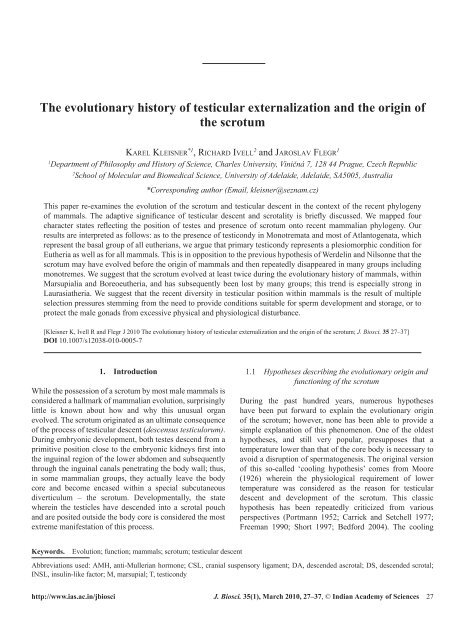

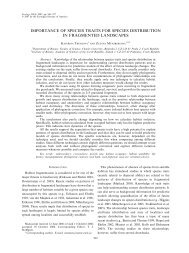
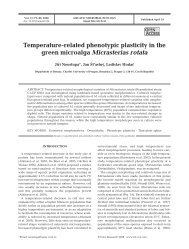
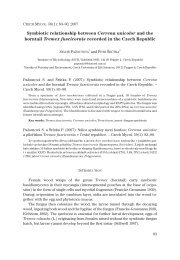
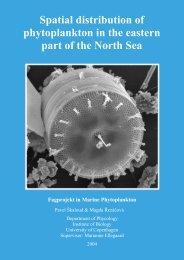
![[Cr(urea)6]Cl3](https://img.yumpu.com/47220263/1/184x260/crurea6cl3.jpg?quality=85)
